
▲한림대성심병원 임홍의교수
Clinical studies with edoxaban
연자 : 한림대성심병원 임홍의 교수
최근 발표된 edoxaban 관련 2건의 연구 결과와 최신 지견을 확장할 수 있는
데이터에 대해 살펴보고자 한다.
The
history of edxoaban
현재 임상에서 사용되고 있는 4가지
NOAC (non-vitamin K antagonist oral anticoagulant) 중 edoxaban은 후발주자로 출시되었고, 2013년 ENGAGE AF-TIMI 48 (Effective Anticoagulation With Factor Xa Next
Generation in Atrial Fibrillation–Thrombolysis in Myocardial Infarction Study
48) 연구 결과가 N Engl
J Med 지에 발표된 것을 시작으로 2017년까지
edoxaban의 유효성과 안전성을 뒷받침하는 다양한 RCT
(randomized controlled trial) 결과가 발표되었다.
2018년 이후로는 RCT를 넘어 실제 진료 현장에서 edoxaban의 효과와 안전성을
뒷받침하는 RWD (real-world data)가 활발하게 발표되고 있으며, 한국인을 대상으로 한 RWD도 진행되어 현재까지 알려져 있는 RCT 결과 외에 다양한 연구 결과가 발표된 바 있다.
NOAC’s
completed/on-going trials
4가지 NOAC의 pivotal study인 dabigatran의 RE-LY (Randomized Evaluation of
Long-Term Anticoagulant Therapy) 연구, rivaroxaban의
ROCKET AF (Rivaroxaban Once Daily Oral Direct Factor Xa
Inhibition Compared with Vitamin K Antagonism for Prevention of Stroke and
Embolism Trial in Atrial Fibrillation) 연구, apixaban의
ARISTOTLE (Apixaban for Reduction in Stroke and Other
Thromboembolic Events in Atrial Fibrillation) 연구,
edoxaban의 ENGAGE AF-TIMI 48 연구에 대해서는 잘 알려져 있고, 다양한 RWD 연구가 진행 중이거나 완료되었다.
PCI (percutaneous
coronary intervention) 시술을 받은 환자를 대상으로 한 연구로는 dabigatran의 RE-DUAL PCI (Evaluation of Dual Therapy With Dabigatran vs. Triple
Therapy With Warfarin in Patients With AF That Undergo a PCI With Stenting) 연구, rivaroxaban의 PIONEER AF-PCI (Open-Label,
Randomized, Controlled, Multicenter Study Exploring Two Treatment Strategies of
Rivaroxaban and a Dose-Adjusted Oral Vitamin K Antagonist Treatment Strategy in
Subjects with Atrial Fibrillation who Undergo Percutaneous Coronary
Intervention) 연구, apixaban의 AUGUSTUS
(A Study of Apixaban in Patients With Atrial Fibrillation, Not Caused by a
Heart Valve Problem, Who Are at Risk for Thrombosis [Blood Clots] Due to Having
Had a Recent Coronary Event, Such as a Heart Attack or a Procedure to Open the
Vessels of the Heart) 연구가 발표된 바 있고, 최근 edoxaban의 ENTRUST-AF PCI (Edoxaban Treatment
Versus Vitamin K Antagonist in Patients With Atrial Fibrillation Undergoing
Percutaneous Coronary Intervention) 연구가 발표되어 PCI 시술
환자에서의 시술 후 항응고 요법에 대한 4가지 NOAC의
연구가 모두 완료되었다.
또한 심방세동 카테터 절제술을 받은 환자에서의 항응고 요법에 대한 dabigatran의 RE-CIRCUIT (Randomised
Evaluation of Dabigatran Etexilate Compared to Warfarin in Pulmonary Vein
Ablation: assessment of different peri-procedural anticoagulation strategies) 연구, rivaroxaban의 VENTURE-AF (A study with 2
treatment strategies in AF patients undergoing radiofrequency catheter ablation)
연구, apixaban의 AXAFA-AFNET 5 (Anticoagulation
using the direct factor Xa inhibitor apixaban during Atrial Fibrillation
catheter Ablation: comparison to VKA therapy) 연구, edoxaban의
ELIMINATE-AF (Evaluation of Edoxaban Compared With VKA in
Subjects Undergoing Catheter Ablation of Nonvalvular Atrial Fibrillation) 연구가
완료되었다.
이외에 TAVI (transcatheter aortic valve implantation) 시술 환자 대상 연구나 고령
환자 대상 연구가 진행 중이다.
ELIMINATE-AF
trial
ELIMINATE-AF 연구는 심방세동 카테터 절제술을
받은 환자에서 시술 전후(periprocedural) 항응고요법을 어떻게 진행할 것인가와 관련하여 edoxaban과 warfarin의 유효성 및 안전성을 비교한 연구이다.
심방세동 카테터 절제술은
출혈 위험을 높일 수 있는 시술이기 때문에 항응고제의 투여를 중단해야 한다고 생각할 수 있지만, 현재
가이드라인 기준으로는 항응고제의 투여를 중단하지 않고 warfarin을 사용할 때에도 uninterrupted anticoagulation이라 하여 시술 전후에 INR
(international normalized ratio) 2.0-3.0을 맞추면서 시술하는 것을 원칙으로 하고 있다. INR을 맞추면서 시술하게 되면 출혈 경향이 증가하지만 카테터 절제술 자체가 혈전을 생성시킬 수 있기 때문에
항응고 요법을 중단하지 않는 것이 표준 권고안으로 제시되고 있다. 약제를 중단하지 않고 사용하는 warfarin은 출혈 관련 문제가 발생하더라도 해독제인 vitamin K를
사용할 수 있기 때문에 상대적으로 안전하게 사용할 수 있지만, NOAC의 경우에는 해독제가 없기 때문에
출혈이 발생했을 때 치명적인 합병증이 발생할 수 있다는 우려가 있었다. 따라서 심방세동 카테터 절제술을
받은 환자에서 uninterrupted warfarin과 비교하여 uninterrupted
NOAC의 차이를 비교하고자 하는 많은 연구가 진행되었고, dabigatran이나 rivaroxaban, apixaban 모두 투여를 중단하지 않고 사용했을 경우 warfarin과 비교하여 안전하게 사용할 수 있다는 결과가 발표되었고, 후발주자인
edoxaban 역시 ELIMINATE-AF 연구를 통해
이러한 결과를 확인하고자 하였다.
1) Study design
ELIMINATE-AF 연구는 무작위 배정 시 edoxaban군과 warfarin군에 2:1 비율로 환자를 배정하여 edoxaban군에 가중치를 두고자 하였고, PROBE (prospective, randomized, open-label trial with blinded
endpoint assessment) design으로 설계되었다(Figure 1). 보통 절제술이나 심율동전환을 하기 전 CHA2DS2-VASc score가 0점이든 1점이든 동 리듬(sinus rhythm)을 돌려주는 리듬 조절을
할 때에는 반드시 3주 전, 4주 후 기간 동안 항응고요법을
시행해야 하기 때문에 ELIMINATE-AF 연구에서도 심방세동 카테터 절제술 시행 전 21-28일간, 시행 후 90일간
항응고제 투여를 진행하였다. 또한 절제술 자체가 혈전을 생성시킬 수 있는 조건을 형성하기 때문에 일부
환자를 대상으로 하위연구를 진행하여 절제술 이후 4±2일
시점에 MRI (magnetic resonance imaging) 검사를 진행하여 subclinical infarcts의 발생률이나 유병률을 확인하고자 하였다.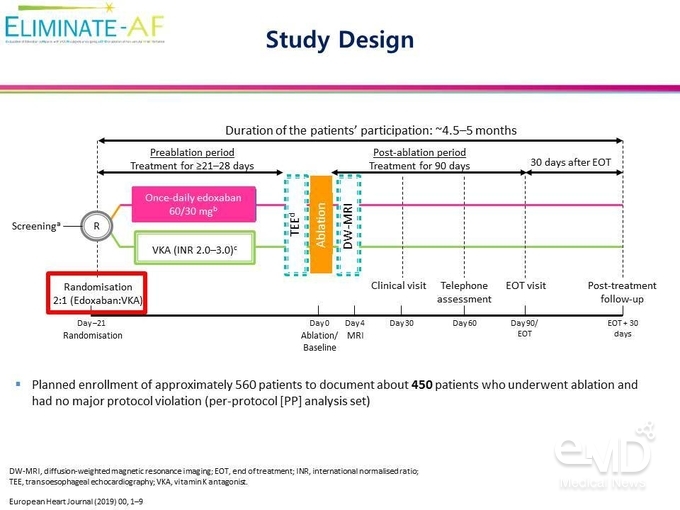
Figure 1. ELIMINATE-AF
연구 디자인
1차 유효성 평가변수는 모든
원인에 의한 사망, 뇌졸중, ISTH (International
Society on Thrombosis and Haemostasis) 정의에 따른 주요 출혈의 복합 평가변수였고, 1차 안전성 평가변수는 주요 출혈이었다. 2차 유효성/안전성 평가변수에 대해서는 1차 유효성/안전성 평가변수에 포함된 항목이나 기타 세부 항목의 개별 평가를 비롯하여 다양한 요소에 대한 평가를 진행하였다. 유효성은 PP (per-protocol) 분석, 안전성은 1회 이상 약제를 복용한 환자를 대상으로 한 modified ITT (intent-to-treat) 분석을 진행하였다.
2) Results
632명의 환자를 screening하였고, 614명을 edoxaban군(n=411)과 warfarin군(n=203)에 무작위 배정하였다. 이 중 약제를 복용하지 않은 환자를
제외한 mITT 환자군은 edoxaban군 405명, warfarin군 197명이었고, 절제술을 받고 추적관찰을 진행한 PP 환자군은 edoxaban군 316명,
warfarin군 101명으로 확인되었다.
▶ Patient demographics
ITT 분석에 포함된 환자군의 특징을
살펴보면 614명 환자의 나이 중앙값은 60.5세로 심방세동
환자 중에서는 다소 젊은 연령에 속하였고, 절제술 대상 환자에는 중증도가 높은 환자가 포함되지 않기
때문에 CHA2DS2-VASc score의 경우 2점 이상인 환자는 50.2%로 높은 비율을 차지하지는 않았으며 대다수의
환자가 0점이나 1점에 해당하였다. 전체 환자군의 평균 CrCl (creatinine clearance)은
96.5 mL/min으로 중증도가 높은 환자가 많이 배제되었다는 점을 확인할 수 있었다. 기존의 다른 NOAC으로 진행된 연구에서는 CrCl을 확인하기 어려웠기 때문에 직접적인 비교는 어렵지만, ELIMINATE-AF
연구에서 확인된 환자군의 CrCl 수치로 미루어 봤을 때 본 연구에는 중증도가 높지 않은
benign 환자들이 많이 포함되었다는 것을 생각해볼 수 있다. 또한
심방세동의 유형은 크게 4가지로 나뉘며, 발작성은 stage I, 지속성은 stage II, 장기간 지속성은 stage III, 영구형은 stage IV에 해당하는데, ELIMINATE-AF 연구에 포함된 약 70%의 환자는 발작성에
해당하여 대부분 benign 환자라는 것을 다시 한번 확인할 수 있었다.
ELIMINATE-AF 연구가 uninterrupted anticoagulation으로 진행된 것은 절제술 시행 전 마지막 약제를 복용한 시간으로
확인할 수 있다. 절제술은 보통 오전에 진행하는데, edoxaban이나
warfarin의 마지막 복용 시간은 시술 전 평균 15.4시간으로
확인되었고, 시술 후 다음 약제를 복용하기 위한 sheath
removal까지의 시간은 평균 6.7시간으로 확인되었다.
즉, 시술 전후 항응고제 복용 시간의 간격은 약 24시간으로
항응고제 복용을 중단하지 않고 지속하면서 절제술을 시행한 연구임을 알 수 있다. Baseline 시점에 항혈소판제를 복용한 비율은 전체 환자군의 5% (23명) 미만으로 매우 낮았다.
▶ Use of UFH and ACT during catheter ablation
Warfarin을 사용했던 환자에서 절제술
진행 시 heparin의 ACT (activated clotting
time)를 300-350초로 유지할 것을 권고하고 있고,
이에 따라 heparin을 투여하게 된다.
ELIMINATE-AF 연구에서는 edoxaban군에서 평균 약 14,000 IU, warfarin군에서 평균 약 11,000 IU의
heparin이 투여되었다. 일반적으로 heparin의 ACT를 300-350초로
유지하기 위해 NOAC을 사용하던 환자에서는 warfarin을
사용하던 환자 대비 많은 heparin의 투여가 필요한 것으로 알려져 있기 때문에 edoxaban군에서 warfarin군 대비 많은 heparin이 투여된 것은 임상적인 의미를 나타내지 않는다.
▶ Primary endpoint
1차 유효성 평가변수 결과에서는
PP 환자군과 mITT 환자군 모두에서 사건의 발생률이 매우
낮아 통계적인 의미를 부여할 수 없었다(Figure
2). PP 환자군에서 절제술 후 1차 유효성 평가변수로 정의된 사건이 발생한 환자
수는 edoxaban군에서 1명(0.3%), warfarin군에서 2명(2.0%)이었고, 절제술 전까지 포함하였을 때에는 각각 4명(1.3%), 3명(3.0%)으로
확인되었다. 이러한 결과는 연구에 등록된 환자의 대다수가 benign
환자이며 1차 유효성 평가변수에 포함된 모든 원인에 의한 사망, 뇌졸중, 주요 출혈과 같은 사건이 발생할 기회가 적었음을 시사한다.
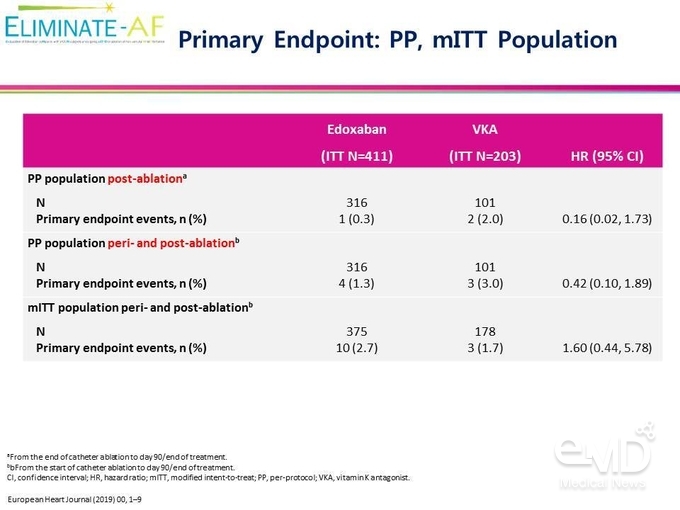
Figure 2. ELIMINATE-AF
연구의 1차 유효성 평가변수 결과
1차 안전성 평가변수 결과
역시 전반적인 사건의 발생률이 매우 낮아 통계적인 의미를 부여할 수 없었다(Figure 3). 주요 출혈의 발생률은 edoxaban군에서 10명(2.5%), warfarin군에서 3명(1.5%)으로 발생률 자체는 warfarin군
대비 edoxaban군에서 높았지만, 통계적인 유의성은 없었다. 이러한 결과는 절제술 전, 전후,
후로 나누어 비교한 경우에도 동일하였다.
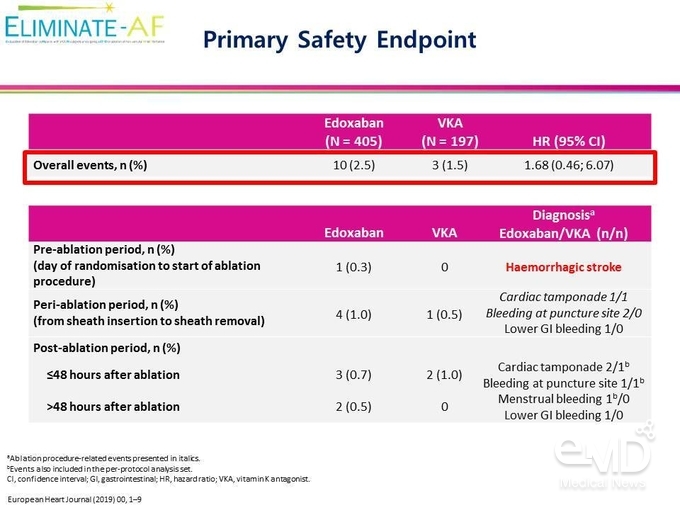
Figure 3. ELIMINATE-AF
연구의 1차 안전성 평가변수 결과
▶ MRI substudy
앞서 언급하였듯이 절제술 자체가 혈전 생성의 위험을 증가시킬 수 있기 때문에 일부
환자를 대상으로 MRI 검사를 시행하여 절제술 후 병변의 발생을 관찰하였다. 절제술 이후 생성되는 병변은 미세한 크기의 병변이 산재되어 있는 형태를 보인다. ELIMINATE-AF 연구의 MRI 하위연구 결과에 따르면 전체
환자군의 약 70%에서는 이러한 병변이 관찰되지 않았고, 나머지
30%의 환자에서는 1-3개의 병변이 관찰되었다. 이 결과는 절제술 전후의 병변 개수를 비교한 것이 아니고 절제술 이후의 병변 개수만을 관찰한 것이기 때문에
이를 절제술 전후 edoxaban이나 warfarin을 복용한
환자 10명 중 3명에서 새롭게 병변이 발생한 것이라 생각하는
것은 적절하지 않다.
Apixaban 관련 연구에서도 유사한 결과가
관찰되는데, MRI 하위연구 결과에서 전체 환자군의 74%에서
병변이 없는 것을 확인할 수 있었고, ELIMINATE-AF 연구와 마찬가지로 이 병변이 새롭게 발생한
병변인지 여부는 알 수 없었다.
3) Summary
ELIMINATE-AF 연구 결과에 따르면 심방세동
카테터 절제술을 시행하는 비판막성 심방세동 환자에서 uninterrupted edoxaban은 warfarin을 대체할 수 있는 약제로 확인되었다. 유효성 또는 안전성
측면에서 평가변수로 지정된 모든 원인에 의한 사망, 뇌졸중, 주요
출혈과 같은 사건의 발생률이 edoxaban군과 warfarin군에서
매우 낮은 수준이었고, 통계적 유의성을 나타내지 않았다.
4) Comparison between NOAC trials for patients
with AF undergoing catheter ablation for AF
심방세동 카테터 절제술을 받은 환자를 대상으로 한 4가지 NOAC의 연구를 비교해보면,
1일 1회 용법으로 복용하는 rivaroxaban과
edoxaban의 경우 시술 전 저녁에 마지막 용량을 복용하도록 하였고, 1일 2회 용법으로 복용하는 dabigatran과
apixaban의 경우 시술 당일 오전에 마지막 용량을 복용하도록 하였다. 시술 전 항응고제 복용 기간은 dabigatran의 경우 4-8주, apixaban의 경우 30일
이상, edoxaban의 경우 21-28일로 거의 유사하였고, rivaroxaban은 TEE (transesophageal
echocardiogram)를 시행하지 않는 경우는 3주 동안 복용하도록 하였고, TEE를 시행하여 혈전이 없는 것을 확인한 경우에는 1-7일간 복용하도록
하였다. 절제술 이후 MRI 검사를 통한 하위연구는 apixaban의 AXAFA-AFNET 5 연구와 ELIMINATE-AF 연구에서만 진행하였다.
심방세동 카테터 절제술 환자를
대상으로 한 4가지 NOAC의 연구에서 유효성 및 안전성
결과는 1차 평가변수로 지정된 사건의 발생이 적어 통계적 유의성을 확인할 수 없었다(Figure 4). 자세히 살펴보면
연구 간 1차 평가변수는 주요 출혈을 포함한 복합 평가변수를 확인한 것인지, 주요 출혈을 단독으로 확인한 것인지 정도에 차이가 있었고, warfarin과
비교했을 때 4가지 NOAC 모두 이러한 사건의 발생이 적었다. AXAFA-AFNET 5 연구에서 apixaban군에서의 사건 발생률이 6.9%로 나타나 다른 NOAC에 비해 높은 발생률을 보였다고 생각할
수 있으나 각 연구마다 대상 환자군의 특징에 차이가 있고 warfarin군에서의 사건 발생률이 7.3%임을 고려할 때 단순히 심방세동 카테터 절제술 환자에서 다른 NOAC 대비
apixaban을 사용할 경우 사망, 뇌졸중, 주요 출혈과 같은 사건의 발생이 많을 수 있다고 결론지을 수는 없다. 2차
평가변수에 있어서도 복합 평가변수를 확인한 것인지, 주요 출혈을 단독으로 확인한 것인지 정도에 차이가
있었고, warfarin과 비교했을 때 edoxaban을
제외한 3가지 NOAC은 이러한 사건의 발생이 더 적은 것을
확인할 수 있었다. 단, edoxaban의 경우 warfarin 대비 주요 출혈의 발생이 많은 경향을 보였으나 발생한 환자의 수가 매우 적고 통계적 유의성을 확인할
수 없었다는 점, 대상 환자군이 연구마다 차이가 있다는 점에서 다른 NOAC
대비 edoxaban의 주요 출혈 발생 위험이 높다고 해석할 수 없다는 것을 고려해야 한다.
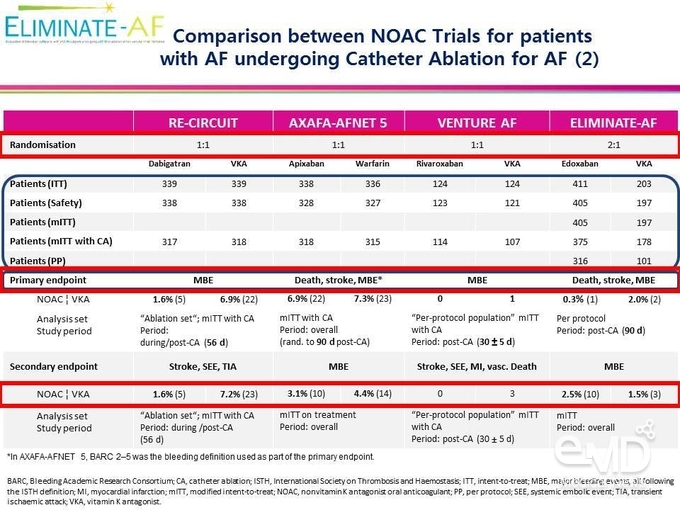
Figure 4. 심방세동 카테터 절제술 환자
대상 4가지 NOAC의 임상연구 결과 비교
ENTRUST
AF-PCI trial
ENTRUST AF-PCI 연구에서는 PCI 시술을 받은
심방세동 환자에서의 항혈전요법과 관련하여 edoxaban과 warfarin의
유효성과 안전성을 비교하였다. PCI 시술을 받은 심방세동 환자에서
항혈전요법의 표준 권고안은 경구 항응고요법과 함께 이중항혈소판제를 복용하는 것인데, ENTRUST AF-PCI 연구에서는
warfarin을 기반으로 한 3제요법과 edoxaban을 기반으로 한 2제요법을 비교하고자 하였다. 나머지 3개 NOAC은
앞서 관련 연구 결과가 발표된 바 있으며, edoxaban은 후발주자로서 마지막으로 연구 결과가 발표되었다.
1) Study design
12개월 이상의 심방세동 치료를
위한 경구 항응고제 적응증에 해당하며 응급상황인 급성관상동맥증후군 환자를 가급적 25% 이상 포함하는
것을 목표로 하여 스텐트 삽입을 통해 성공적인 PCI 시술을 받은 환자 1,500명을 sheath removal 후 5일 이내 edoxaban+P2Y12 억제제 투여군
또는 warfarin+P2Y12 억제제+aspirin
투여군(aspirin 1-12개월 투여)에 무작위
배정하였다.
이후 12개월까지 치료하여 1차 평가변수로서 ISTH 정의에 따른 주요 출혈 또는 임상적으로 연관된
비주요 출혈의 복합 평가변수를 확인하였고, 2차 평가변수로서 심혈관 원인에 의한 사망, 전신색전성 사건, 자발성 심근경색,
academic research consortium criteria에 따른 명확한(definite) 스텐트 혈전증의 복합 평가변수를 확인하였다. 탐색적
평가변수로서 다양한 평가변수가 정의되었는데, 이 중 net
clinical benefit은 심혈관질환, 뇌졸중, 전신색전성
사건, 자발성 심근경색, 명확한 스텐트 혈전증, ISTH 정의에 따른 주요 출혈의 복합 평가변수로 정의되었다. 통계분석은
주요 출혈 및 임상적으로 연관된 비주요 출혈에 대해 warfarin 요법 대비 edoxaban 요법의 비열등성을 검증하고, 비열등성을 만족한 경우
우월성을 검증하는 단계적 분석을 진행하였다.
1,506명의 환자 중 edoxaban군과 warfarin군에 각각 751명, 755명이 무작위 배정되었고, 연구 종료 시점에 각각 616명,
580명이 치료를 완료하여 연구를 완료한 환자의 비율이 warfarin군 대비 edoxaban군에서 높은 경향을 보였다. Edoxaban군에서는 130명의 환자가, warfarin군에서는 160명의 환자가 치료를 중단하여 많은 수의 환자가 치료 중 연구를 중단한 것으로 확인되었는데, 연구 진행 중 출혈로 인해 약제 투여를 중단한 환자가 많았다는 것을 생각해볼 수 있다.
2) Results
▶Baseline characteristics
연구에 등록된 환자의 나이 중앙값은 edoxaban군이
69세, warfarin군이 70세였고, 등록된 여성 환자의 비율은 25-26%였다. CHA2DS2-VASc
score와 HAS-BLED score의 중앙값은 두 군 모두에서 각각 4.0점, 3.0점으로 차이를 보이지 않았으며, 질환과 관련된 과거력에 있어서도 양 군 간 차이를 보이지 않았다. Edoxaban군과
warfarin군에서 심근경색의 과거력이 있는 환자의 비율은 각각 25%,
23%였고, 이전 PCI 시술 경험이 있는 환자의
비율은 각각 26%였으며, 이전 CABG (coronary artery bypass graft) 시술 경험이 있는 환자의 비율은 각각 6%, 7%로 확인되었다. 급성관상동맥증후군 환자를 25% 이상 포함시키는 것을 목표로 한 만큼 PCI 시술이 필요했거나
불안정한 상태의 환자가 상당수 포함된 것을 확인할 수 있었다.
등록된 환자 중 아시아 환자의
비율은 두 군에서 11-12%로 유사하였고, 급성관상동맥증후군의
임상 증상이 확인된 환자가 각 군에서 52%로 확인되었다. PCI 시술
종료 후 무작위 배정까지의 시간(중앙값)은 edoxaban군이 45.1시간,
warfarin군이 44.8시간으로 유사하였고, 90% 이상의
환자가 출혈 위험이 낮은 clopidogrel을 사용하였고 7-8%의
환자가 ticagrelor를 사용하였으며 prasugrel 5 mg 또는
10 mg을 사용한 환자의 비율은 각 군에서 2% 미만이었다.
▶Outcomes
1차 평가변수인 ISTH 정의에 따른 주요 출혈 또는 임상적으로 연관된 비주요 출혈의 발생률을 살펴보면 edoxaban을 기반으로 한 항혈전요법이나 warfarin을 기반으로
한 항혈전요법에서 5명 중 1명이나 4명 중 1명은 유형에 관계없이 1년내
출혈을 경험한 것으로 확인되어 상당수의 환자에서 출혈 발생의 위험이 있었다는 것을 알 수 있었다. ITT 분석에서
연간 주요 출혈 또는 임상적으로 연관된 비주요 출혈의 발생률이 edoxaban군에서 20.7%, warfarin군에서 25.6%로 edoxaban군의 경우 warfarin군 대비 출혈 발생 위험이 17% 낮은 것으로 확인되었고, 비열등성에 있어 통계적 유의성을 나타냈다(P=0.0010). On-treatment 분석에서도 1차 평가변수의 연간 발생률이 edoxaban군에서 20.7%, warfarin군에서 25.5%로 ITT 분석과 마찬가지로 warfarin 대비 edoxaban의 비열등성을 확인할 수 있었다(P=0.0016). 단, 비열등성
검증에 이어 단계적으로 진행된 우월성 검증에서는 warfarin 대비 edoxaban의 출혈 위험 감소에 대한 우월성은 통계적으로 유의하지 않았다.
1차 평가변수의 결과를 시간
경과에 따라 살펴보면 무작위 배정 후 30일 이내에는 edoxaban군의
출혈 발생이 warfarin군 대비 높은 경향을 보였으나 이후 역전되어 차이가 점점 증가하는 양상을
보였다(Figure 5). 이러한
결과가 나타난 배경을 살펴보면, 처음 warfarin을 사용했을
때 INR 2.0-3.0으로 맞추고 사용한 것이 아니라 무작위 배정된 후 saturation될 때까지 30일 정도의 기간이 필요했다. 따라서 INR 2.0-3.0으로 적정되지 않은 상태에서 warfarin군에 무작위 배정되었고, edoxaban군의 경우에는
약제 복용 후 12시간 정도 경과하면 full saturation이
되기 때문에 처음 30일 기간 동안에는 역전된 결과를 보여준 것으로 생각된다. 이처럼 30일 이후 출혈 발생 양상이 역전되는 결과는 ENTRUST-AF PCI 연구에서만 관찰된 것이 아니라 다른 3가지
NOAC의 관련 연구에서도 관찰되었다.
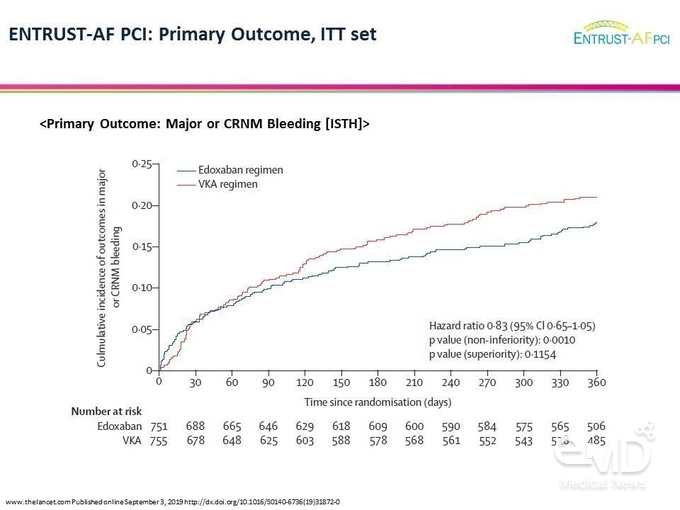
Figure 5. ENTRUST-AF
PCI 연구의
1차 평가변수 결과
지리적 차이, CrCl 등을 기준으로
분류한 하위분석 결과에서도 edoxaban군은 warfarin군
대비 ISTH 정의에 따른 주요 출혈 또는 임상적으로 연관된 비주요 출혈의 발생 위험을 낮추는 데 비열등성을
보인 것으로 확인되었다. 단, ENTRUST-AF PCI 연구에
포함된 환자에 아시아 환자의 비율이 높지 않았기 때문에 이러한 결과가 한국 환자에서 그대로 적용된다고 보기는 어렵다.
1차 평가변수 중 ISTH 정의에 따른 주요 출혈에 대해서만 분석한 결과에서도 연간 발생률이 edoxaban군에서
6.7%, warfarin군에서 7.2%로 나타났고 통계적으로
두 군 간 유의한 차이를 보이지 않았다. 이러한 결과는 PCI 시술
후 3제요법이나 2제요법으로 항혈전요법을 받은 심방세동 환자
100명 중 6-7명은 주요 출혈을 경험할 수 있다는 것과
항혈소판제가 추가되는 경우 출혈 경향이 높아진다는 것을 시사하였다.
ITT 분석에서 2차 유효성 평가변수인 심혈관계 사망, 뇌졸중, 전신색전성 사건, 심근경색 또는 명확한 스텐트 혈전증의 복합 평가변수에
대한 연간 발생률은 edoxaban군이 7.3%, warfarin군이
6.9%로 warfarin 대비 edoxaban의 비열등성을 확인하였다.
3) Summary
결론적으로 PCI 시술을 받은 심방세동 환자에서 표준용량 edoxaban을 기반으로
한 2제요법은 12개월의 치료 기간 동안 warfarin을 기반으로 한 3제요법 대비 주요 유효성 결과에서 차이를
보이지 않았고, 출혈 발생 위험에 대해서도 비열등성을 입증하였다.
4)
Limitations
ENTRUST-AF
PCI 연구에서 warfarin군의 치료 중단 비율이 다소 높았고, 유효성 결과를
확인하기에는 충분한 환자 수가 등록되지 않았다는 점을 제한점으로 볼 수 있다.
5) Comparison of 4 NOAC AF PCI trials
PCI 시술 환자를 대상으로 한
4가지 NOAC의 임상연구 결과를 비교해보면, ENTRUST-AF PCI 연구의 경우 환자 등록까지 소요된 시간의 중앙값이 45.1시간으로 6-7일 정도의 기간을 보인 다른 NOAC 연구와 달리 이틀 이내 빠르게 약제를 투여했다는 장점을 보여주었다. 또한
추적관찰 기간에 있어서도 ENTRUST-AF PCI 연구에서는 최대 12개월까지
진행하여 6개월-12개월 정도 추적관찰한 다른 NOAC 연구보다 길거나 유사하게 추적관찰을 진행하였다.
등록 시 제외된 환자 기준에 있어서도 다른 NOAC
연구에서는 CrCl 기준을 30 mL/min 미만으로
잡았으나 ENTRUST-AF PCI 연구에서는 15 mL/min 미만으로
하여 출혈 위험이 높은 환자를 더 많이 포함하고자 하였다. 단, 아직까지
ENTRUST-AF PCI 연구에 등록된 CrCl 15-30
mL/min인 환자의 비율은 확인할 수 없기 때문에 ENTRUST-AF PCI 연구에 등록된
환자군이 다른 NOAC 연구에 등록된 환자군 대비 취약하다고(fragile)
결론 짓기는 어렵다. 등록된 환자 중 급성관상동맥증후군을 경험한 환자의 비율은 PIONEER-AF PCI 연구에서 52%, RE-DUAL PCI 연구에서
50%, AUGUSTUS 연구에서 PCI 시술을 받은 경우
37.3%, 시술을 받지 않은 경우 23.9%로 확인되었고, ENTRUST-AF PCI 연구에서도 52%의 환자가 급성관상동맥증후군을
경험한 것으로 확인되었다.
1차 평가변수 결과에 있어
rivaroxaban, dabigatran, apixaban은 각각의 임상연구를 통해 warfarin 요법 대비 우월성을 입증하였으나 edoxaban의 경우
우월성을 입증하지는 못하고 비열등성을 입증하였다. 결과만 놓고 보았을 때에는 다른 NOAC 대비 edoxaban의 결과가 미진한 것으로 추정할 수 있다. 그러나 다른 NOAC의 경우 연구에서 3제요법으로 치료한 기간을 길게 가져간 환자의 비율이 높았기 때문에 warfarin군에서
출혈이 발생할 수 있는 기회가 높았던 반면, ENTRUST-AF PCI 연구에서는 30일째 3제요법 치료를 중단한 환자의 비율이 46%로 높아 차이가 있었다. ENTRUST-AF PCI 연구에서 30일 시점 이후에는 대조군의 대다수 환자가 aspirin을 중단하고
2제요법으로 치료를 받았기 때문에 사실상 3제요법과 2제요법의 비교가 아니었다고 볼 수 있고, 이러한 차이가 우월성 검증에
영향을 주었을 것으로 추정되었다.
PCI 시술 환자 대상 4가지 NOAC의 임상연구에서 심근경색이나 스텐트 혈전증의 발생 위험은
warfarin을 기반으로 한 3제요법 대비 NOAC을 기반으로 한 2제요법에서 높은 경향을 보였으나 통계적인 유의성은
없는 것으로 확인되었다.
New risk stratification
for stroke
1) Adjuvant or novel risk scheme for stroke
심방세동 절제술을 시행하는 환자군
자체에 편향이 있고 시술 후 환자의 특징이 많이 변화하게 되는데, 현재 가이드라인은 CHA2DS2-VASc score에 따라 항응고요법을 진행하도록 유도하고
있지만 데이터 측면에서 이러한 권고안을 뒷받침하지 못하고 있다.
현재 뇌졸중 위험을 평가하는 도구로 사용되고 있는 CHA2DS2-VASc
score에 대해서는 여러 가지 논쟁이 있다. 여성이 위험인자로 포함되는 것에 대한 이의를
바탕으로 성별을 제외한 nongender-related CHA2DS2-VASc
score (CHA2DS2-VA score)가 제안된 바 있고, 임상적으로 저위험 환자군에 해당하는 CHA2DS2-VASc
score 0점 또는 1점인 경우에도 뇌졸중이 발생할 수 있기 때문에 현재 기준이 되고
있는 CHA2DS2-VASc score에 대한 미충족 요구(unmet needs)가 있다는 것을 알 수 있다. 이외에도 코카시아(Caucasian) 환자에서는 나이의 cut-off value를 65세를 기준으로 하고 있지만 아시아 환자에서는 여러 연구 결과를 바탕으로 50세나
60세를 cut-off value로 설정해야 한다는 의견이
제기되고 있다. 또한 뇌졸중 위험을 평가하는 도구에는 심방세동 부담에 대한 차이, 즉 리듬 조절을 했던 군과 심박수 조절을 했던 군 사이에 심방세동의 부담에 차이가 있기 때문에 이러한 심방세동
부담의 차이가 고려되어야 한다. 뿐만 아니라 CHA2DS2-VASc
score는 환자의 상태를 파악하는 임상적 지표에 해당하기 때문에 좌심방의 크기, 기능, 실험실 결과와 같은 biomarker의 역할이 충분히 반영될 수
있는 뇌졸중 위험 평가도구가 필요한 상황이다.
2) Markers for prediction for stroke after
catheter ablation of AF
국내 데이터를 수집하여 심방세동
카테터 절제술 이후에 뇌졸중이 발생하는 데 영향을 미치는 지표에 대한 분석을 진행하여 2019년 J Cardiovasc Electrophysiol 지에 발표하였다.
3개 국내 기관에서 2000-2016년까지 심방세동 절제술을
받은 환자 3,464명의 데이터를 수집하였고, 분석에 포함된
환자의 평균 나이는 60세, 평균 CHA2DS2-VASc score는 1.5점으로
심방세동 환자 중에서는 나이가 젊고 증상이 경미한 환자가 포함되었다. CHA2DS2-VASc
score가 높을수록 뇌졸중의 발생률이 증가하는 경향을 반영하여 expected rate를
계산하였고, 심방세동 카테터 절제술 이후 관찰된 뇌졸중의 발생률을 observed
rate로 확인하였을 때 expected rate 대비 observed
rate가 크게 감소하는 양상을 보였다. RRR (relative risk reduction)은
81%로 심방세동 카테터 절제술을 받지 않은 경우 대비 받은 경우 뇌졸중 발생 위험이 크게 감소하는
것으로 확인되었다.
심방세동 카테터 절제술 이후에 항혈전제의
사용 경향을 비교했을 때 항혈전제를 사용하지 않은 환자가 38%, 단일항혈소판제를 사용한 환자가 35.2%, warfarin을 사용한 환자가 9.4%, NOAC을 사용한
환자가 17.5%였다. 상당히 많은 수의 환자가 예상과 달리
경구 항응고제를 유지하지 않고 약제를 사용하지 않거나 aspirin과 같은 항혈소판제만을 사용하는 경향을
보였음에도 뇌졸중의 발생 위험이 낮은 것으로 확인되었다.
등록된 환자를 대상으로 뇌졸중을 예측하는 지표에 대해 분석을 진행한 결과, 단변량 분석에서는
심방세동 카테터 절제술 이후에 뇌졸중의 발생을 예측하는 데 CHA2DS2-VASc
score가 유의하지 않은 것으로 나타났고, 다변량 분석에서는 심방세동 카테터 절제술 이후의
뇌졸중 발생 예측에 대한 독립적 위험인자에 동 리듬 유지 여부에 관계없이 이전 뇌졸중 과거력이 있는 경우가 포함되었다(Figure 6). 이러한 결과로 미루어볼 때 심방의 기능에 문제가 있는 경우 동 리듬이 유지되더라도
경구 항응고요법을 유지하는 것이 적절할 것으로 생각된다. 두 번째 독립적 위험인자는 신장기능으로 CrCl이 낮을수록 뇌졸중의 위험이 증가하는 것으로 확인되었다. 세
번째 독립적 위험인자는 좌심방 직경으로 통계적 유의성은 없었지만 경향성을 나타냈고, 심방세동의 재발은
독립적 위험인자로서 통계적 유의성을 보이지 않았다.
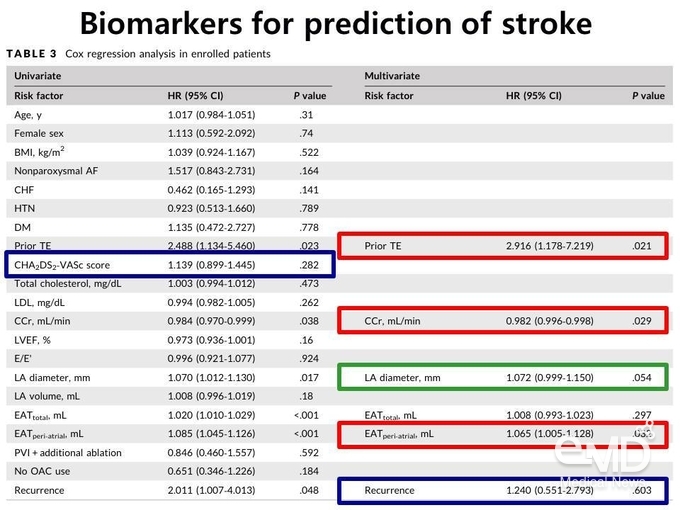
Figure 6. 심방세동 카테터 절제술 이후
뇌졸중 발생 예측을 위한 바이오마커 분석 결과
3) True low-risk of stroke in AF patients
CHA2DS2-VASc score 0점 또는 1점에 해당하는 임상적으로 저위험 심방세동 환자에서 뇌졸중의 유병률은 어떠한지,
뇌졸중이 발생한 환자는 어떠한 위험인자를 가지고 있었는지 후향적으로 분석한 국내 코호트 연구 결과가 2019년 J
Am Heart Assoc 지에 발표되었다.
서울 3개 기관, 경기도 3개
기관, 대전 1개 기관, 부산
2개 기관에서 2013-2016년까지의 데이터를 수집하여
색전성 뇌졸중과 심방세동으로 진단된 3,033명의 환자를 분석하였다.
583명(19.2%)의 환자는 nongender-related
CHA2DS2-VASc score 0-1점에 해당하였고,
462명(15.2%)의 환자는 CHA2DS2-VASc
score 0-1점에 해당하였다. 이러한 결과는 실제적으로 뇌졸중의 위험이 낮은 것으로
평가되는 환자에서도 10명 중 1.5-2명은 뇌졸중이 발생할
수 있다는 것을 시사한다.
심방세동의 유형과 CHA2DS2-VASc score를 매칭하는 nearest neighbor method를 사용하여 뇌졸중이 발생한 환자군과 대조군의 baseline 특징을 비교하였다. 또한 단병량 및 다변량 분석을 통해
심방세동 환자의 뇌졸중과 연관된 인자를 분석한 결과, 나이,
NT-proBNP (N-terminal probrain Natriuretic Peptide), CrCl, 확장된 좌심방이 뇌졸중과
연관된 인자로 확인되었다. 첫 번째 인자인 나이는 60세
이상인 경우, 두 번째 인자인 NT-proBNP는 300 pg/mL 이상일 때, 세 번째 인자인 CrCl은 50 mL/min 미만인 경우, 네 번째 인자인 확장된 좌심방은 크기가 45 mm 이상일 때 임상적으로
저위험에 해당하더라도 뇌졸중의 발생 위험이 유의하게 높은 것으로 나타났다.
이를 ABCD score라 하고 각 인자의 위험비를 고려할 때 가중치를 두지 않은 상태에서 각 1점으로 계산하였을 때 true-low risk를 감별하는 C-index에 대해 CHA2DS2-VASc
score의 C-index가 0.548인 것과
대비하여 ABCD score의 C-index는 0.858로, true-low risk를 감별하는 데 통계적으로 유의한
것으로 확인되었다(Figure 7). 또한 ABCD
score를 0-4점으로 나누어 예상되는 뇌졸중 사건의 수와 실제 관찰된 뇌졸중 사건의
수를 비교했을 때 거의 유사한 경향을 보였다.
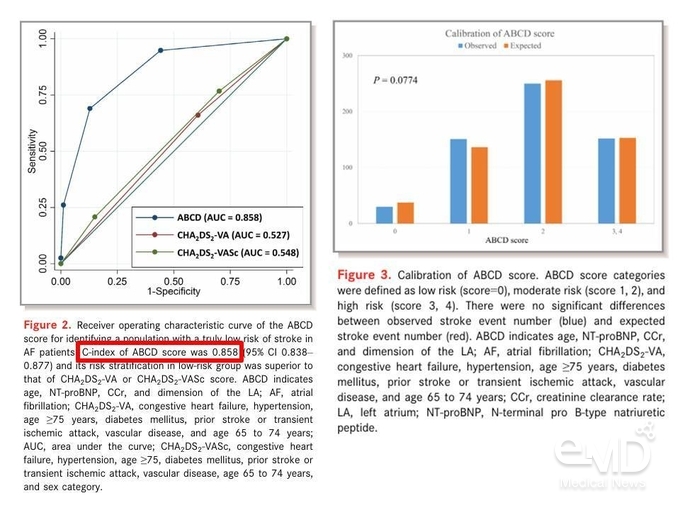
Figure 7. 심방세동 환자에서 뇌졸중
발생 예측 평가도구로서의 ABCD score
본 연구 결과는 심방세동 환자에서 CHA2DS2-VASc
score를 통한 뇌졸중 위험 평가를 평가 절하하는 것은 아니며, CHA2DS2-VASc
score 0-1점의 저위험 환자군에서도 뇌졸중의 발생 위험이 20% 정도로 높기 때문에
이 환자군에서 true-low risk를 배제하고, 고위험군에서
경구 항응고요법을 시행하는 것이 적절하며, 이러한 환자군을 선별하는 데 있어 ABCD score의 유용성을 뒷밤침하는 연구 결과라 할 수 있다.
Edoxaban: On-going
study









